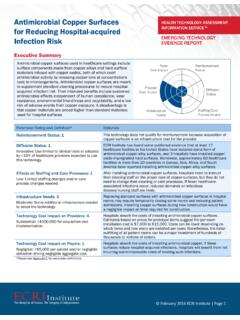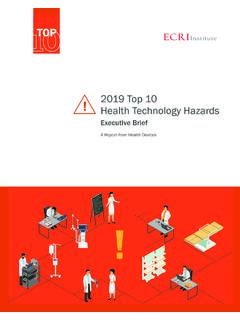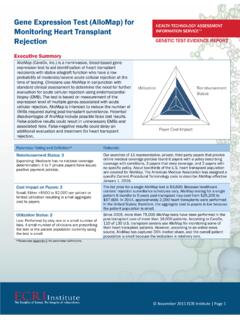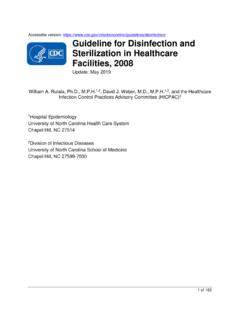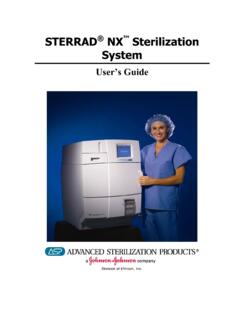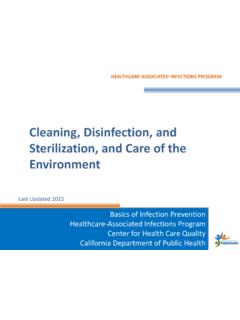Transcription of Disinfection Robots: A front-line assault on hospital ...
1 24 2015 The thoroughness of terminal cleaning of patient rooms ( , thorough environmental cleaning and Disinfection of patient rooms after patient discharge or transfer) in acute care hospitals is one area of focus to reduce HAIs and improve patient care. Recently, some hospitals have adopted portable enhanced environmental Disinfection systems (robots) that feature ultraviolet -C (UV-C) light or hydrogen peroxide vapor (HPV) to complement infection control protocols already in place to battle hospital -acquired Clostridium difficile (C. diff), methicillin-resistant Staphylococcus aureus (MRSA), and other multi-drug-resistant organisms.
2 Disinfection robotics evolved out of the need to reduce HAIs without incurring additional labor costs. While Disinfection robots are new, the two methodologies for disinfecting rooms during terminal cleaning procedures hydrogen peroxide and ultraviolet processes are not. UV-C light has been used to decontaminate drinking water and air handling systems for many years, and UV-C and HPV have been used in clean room environments by the pharmaceutical industry for more than a decade. UV-C deactivates DNA and RNA, and HPV utilizes oxidative processes to kill microorganisms, including TECHNOLOGY TO CHOOSE: ultraviolet light and hydrogen peroxide vaporizationOne supplier, Lumalier Corp.
3 (Memphis, TN, USA), offers a UV-C system the TRU-D SmartUVC with its proprietary Sensor360 that calculates the UV time and dose required based on room size, geometry, surface reflectivity to UV-C, and equipment in the room. In a single-patient room, decontamination takes about 25 minutes for MRSA and 45 minutes for C. diff. The robot is wheeled into a room that has already undergone terminal cleaning. The machine is activated remotely because no one can be in the room during system use. A large circular shaft featuring long UV-C tubes shines UV-C light on all room surfaces and objects to kill pathogens.
4 Published environmental-surface study results have indicated the technology eradicates pathogens, and Lumalier has stated that an ongoing study of the TRU-D system (funded by CDC) is comparing HAI rates after standard chemical cleaning plus UV-C disinfecting with the UV-C device, the Xenex , by Xenex Disinfection Services (San Antonio, TX, USA), uses pulsed xenon. According to Xenex, the system requires five-minute cycles in multiple positions in a typical patient room to kill C. diff., and in this time frame all other pathogens are eliminated.
5 Several hospitals have released data on reduced C. diff and MRSA infection rates in conjunction with this pulsed xenon UV-C system. While the technology is important, it is also critical to implement a bundled approach to reducing HAIs. Education, enhanced hand-hygiene protocols, advanced cleaning procedures, and contact precautions all lead to a safer hospital addition to light technology, HPV can be used for Disinfection purposes. Bioquell, Inc. (Horsham, PA, USA) markets its Q-10 robot system to healthcare facilities. The system uses two machines: the first unit releases a 35 percent hydrogen peroxide solution into the air, and the second aerates the room.
6 The robots resemble portable air-conditioning units. As with the UV-C devices, this system features remote activation because no one can be in the room during use. In addition, air conditioning and heating vents, as well as spaces around the door, must be sealed during use. The process does not harm electronic equipment. According to the Battles may be lost or won on the hospital -acquired infection (HAI) front, but the war wages on as pathogens mutate to resist the latest antibiotics and disinfectants. HAIs are a significant problem. According to the Centers for Disease Control and Pre-vention (CDC), a survey of acute care hospitals found 1 in 25 hospital patients has at least 1 HAI on any given day and that 75,000 deaths per year are due to HAIs.
7 ECRI UPDATED isinfection Robots: A front-line assault on hospital -acquired infections?24 2015 THE BENCH company, a single-patient room without a bathroom takes 90 minutes to the technology, note that the available no-touch technologies such as UV-C light irradiation and vaporized/aerosolized hydrogen peroxide can be used only for terminal room Disinfection because they are hazardous to patients and staff. Also, the number of robots you decide to acquire should be determined according to your room turnover needs and the time required to AND REIMBURSEMENTW hile disinfecting robot technology is costly, there s a direct correlation to reducing infection risk for inpatients, costs for treating HAIs, and patients length of stay.
8 According to ECRI Institute s SELECT plus pricing database, Bioquell s Q-10 HPV system has an average price of approximately $47,000, the Xenex UV-C system costs approximately $81,000, and the TRU-D UV-C system costs $125,000. Service contract costs should also be considered as part of any lifecycle cost analysis. The Centers for Medicare & Medicaid Services (CMS) assesses hospitals readmission payment adjustments using three readmission measures endorsed by the National Quality Forum: heart attack, heart failure, and pneumonia. CMS is finalizing its proposal to add two new readmission measures, which will be used to calculate readmission penalties beginning in fiscal year 2015: readmissions for hip/knee arthroplasty and chronic obstructive pulmonary disease.
9 Disincentives, such as lower reimbursement payments, are expected to continue, and any higher costs incurred due to HAIs may not be reimbursed at these technologies could have large positive implications for infection prevention practices and capital and operational budgets. In addition, administrators could see a return on investment due to fewer staff-contracted infections and loss of work time. Implementing Disinfection robotics might not only improve patient health outcomes, but also bring about significant savings and cost avoidance for healthcare FACTS TO CONSIDER Consider introducing Disinfection robots into intensive care units and other high-infection-risk patient care areas, but understand these technologies do not obviate the need for other infection control practices.
10 Smooth introduction requires that infection control/prevention departments and hospital value analysis and technology assessment departments work together when considering whether to implement Disinfection robots. These technologies are costly. Consider trialing the robots to assess their optimal value in terms of type of technology and locations in which to use them. For the trial, collect data on pre- and post-implementation hospital infection rates (including number and types of pathogens), patient clinical and infection information, readmission rates, Disinfection time, and room downtime.
